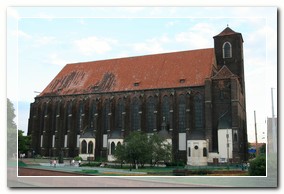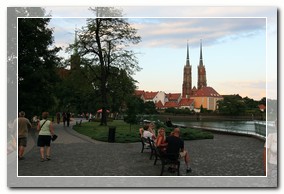


 he rag of sand around the Sand Island already served
in the ancient times as a ford enabling crossing the Oder. This was the
way where the famous amber route run, used by the tradesfolk to
transport the valuable fossilized resin from the Baltic Sea to the
centre of trade of amber Aquileia and farther to all important cities of
the ancient world. There was a time when the amber was worth its weight
in gold. Romans believed that it had healing and magical proprieties (it
burns, and if one rubs it on wool it electrifies and attracts scraps). A
proof that the amber traders hearses used to drive here, are the Roman
coins, ceramics and articles made of bronze coming from the sunny Italy
found in the neighborhood, but most of all large quantities of amber,
he rag of sand around the Sand Island already served
in the ancient times as a ford enabling crossing the Oder. This was the
way where the famous amber route run, used by the tradesfolk to
transport the valuable fossilized resin from the Baltic Sea to the
centre of trade of amber Aquileia and farther to all important cities of
the ancient world. There was a time when the amber was worth its weight
in gold. Romans believed that it had healing and magical proprieties (it
burns, and if one rubs it on wool it electrifies and attracts scraps). A
proof that the amber traders hearses used to drive here, are the Roman
coins, ceramics and articles made of bronze coming from the sunny Italy
found in the neighborhood, but most of all large quantities of amber,
 which does not occur naturally on the these grounds. On the terrain of
Wroclaw's housing Partynice an amber treasure from the I century A.D.
weighing over 2750 kilograms was found! The name of the island comes
from the church of the Holiest Virgin Maria on Sand: the Latin name of
the church is Sancta Maria in Arena and comes from the roman church of
saint Maria built in the place of the former arena, on which first
Christians died from a horrible death during the persecutions.
which does not occur naturally on the these grounds. On the terrain of
Wroclaw's housing Partynice an amber treasure from the I century A.D.
weighing over 2750 kilograms was found! The name of the island comes
from the church of the Holiest Virgin Maria on Sand: the Latin name of
the church is Sancta Maria in Arena and comes from the roman church of
saint Maria built in the place of the former arena, on which first
Christians died from a horrible death during the persecutions.
While being on the Sand Island it is worth to see:
- The church of the Holiest Virgin Maria on Sand
- The Gothic Little house, formerly the Saint Ann church
- The Library on sands (former Augustan’s monastery)
- The Sand Bridge
- The Maria Mill
- The Walking Promenade, from which one can go on a cruise on the Oder















